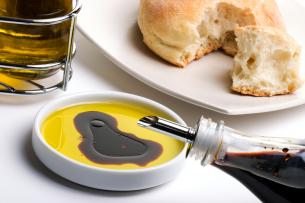
What is balsamic vinegar anyway?
Balsamic vinegar is a reduction made from grapes, but it is not considered a wine vinegar because the grape juice used is unfermented. The unfermented white sweet grape juice that is used is called “must” and comes from Trebbiano grapes.
First, the grape juice is cooked slowly in a copper cauldron until it is reduced by 35 to 50 per cent. Then, the reduction is placed (along with a bit of already-aged vinegar to get the process started) into oak barrels to age. Each year, some of the vinegar evaporates, and the vinegar is transferred into a smaller barrel made of a different wood (chestnut, cherry, juniper, mulberry, cacia, and ash are commonly used). Each wood used infuses a different flavor into the vinegar, making it more complex and interesting. And as the vinegar ages and becomes concentrated, it becomes thick, sweet and dark.
This process originated in the northern Italian city of Modena. If balsamic vinegar is made following the standards of Modena (which includes each type of wood barrel) and passes a rigorous taste test, it may be deemed Tradizionale di Modena. Reggio-Emilia is another Italian city where traditional balsamic vinegar is made (vinegars made here would be called tradizionale di Reggio-Emilia). These vinegars are expensive and are wonderful for flavoring meat, as a dip for strawberries, and even as a flavoring for a sweet beverage. Some desserts, including panna cotta, crème caramel and zabaglione, may call for this vinegar.
You might be more familiar with a more commercial version of balsamic vinegar, which has a much shorter aging process. Often, some of the traditional barrels are skipped (and in many cases, only oak is used). This vinegar is fantastic for using in salad dressings, marinades, sauces, and pastas. Deborah of Play with Food has it on her list of essential pantry items.
How can I use balsamic vinegar in my cooking?
There are three basic age groups of balsamic vinegar, and each is used differently:
The youngest group, 3 to 5 years, is good for salad dressings, dipping sauces for vegetables and bread, sauces and marinades.
The middle age group, 6 to 11 years, is more viscous and is quite versatile. Use it in sauces (at the end of cooking), in risotto and pasta dishes, in marinades and mixed with mayonnaise or sour cream for a sandwich condiment.
Well-aged balsamic vinegar (12 to 150+ years) is best used after the cooking is finished, and in otherwise mild dishes (nothing spicy or heavily seasoned), so it can shine on its own. Use it to flavor meat like chicken, steak, fish or veal. It is well-suited to fruit and cheese pairings, such as strawberries, peaches and pears, along with ricotta or feta cheese. It may be enjoyed by itself (just a tiny amount) or added to water (or sparkling water) for a refreshing beverage.
OK, it’s on my grocery list. What’s the best kind to get?
If you want the thick, sweet, complex Tradizionale, look for a label that has the phrase Aceto Balsamico Tradizionale di Modena, which is a term applied only to the best balsamics. Expect to pay a good amount for this vinegar. You will only use it in drops, so it will last a while. Condimiento vinegars will also be high-quality, as they are made in the same way as the tradizionale, though they may be produced outside Modena.
If you are looking for a more accessible balsamic, check the ingredients to make sure no sugar is added. Often, low-quality vinegar is bitter, and brown sugar may be added to help mask its inferiority. True balsamic vinegar only has one ingredient: must. You may also note the age of the vinegar, if the bottle is labeled with this information. In general, more aged balsamic vinegar is better.
Some markets will have balsamic vinegars that you can buy by filling glass bottles yourself. Often at these shops, you are able to taste the vinegars before buying. This is the best way to make sure the vinegar you are taking home with you agrees with your palate and has a balanced flavor.
It’s in my pantry now. Know any good recipes?
Pork chops and spinach with balsamic reduction is a quick and simple recipe for a weeknight dinner. Don’t be scared off by the term “reduction” – it just means that the balsamic vinegar gets simmered, and thickens into a saucy consistency.
Asparagus, pea, bruschetta pasta uses balsamic vinegar in a different twist on the bruschetta topping.
Chicken and Peppers with Balsamic Vinegar is a colorful dish that would be perfect for a summer potluck.
Grilled Eggplants with Fresh Mint and Balsamic Vinegar sounds like the perfect spring dinner, maybe served with risotto!
Mascarpone Mousse with Balsamic Vinegar Caramel is a light, delicious dessert.
Phantom Gourmet’s Tuscan Sliders are topped with gorgonzola cheese and a balsamic pomegranate reduction.
Strawberry Risotto with Balsamic Vinegar looks and sounds amazing!
And since strawberries and balsamic vinegar seem to be a match made in heaven, you may want to try Strawberry Balsamic Sherbet.
If you are new to startcooking, or are a regular visitor here, please consider subscribing for free.








































Andy said:
That is a great post. I like the ones where you learn something new (and this is all new to me).